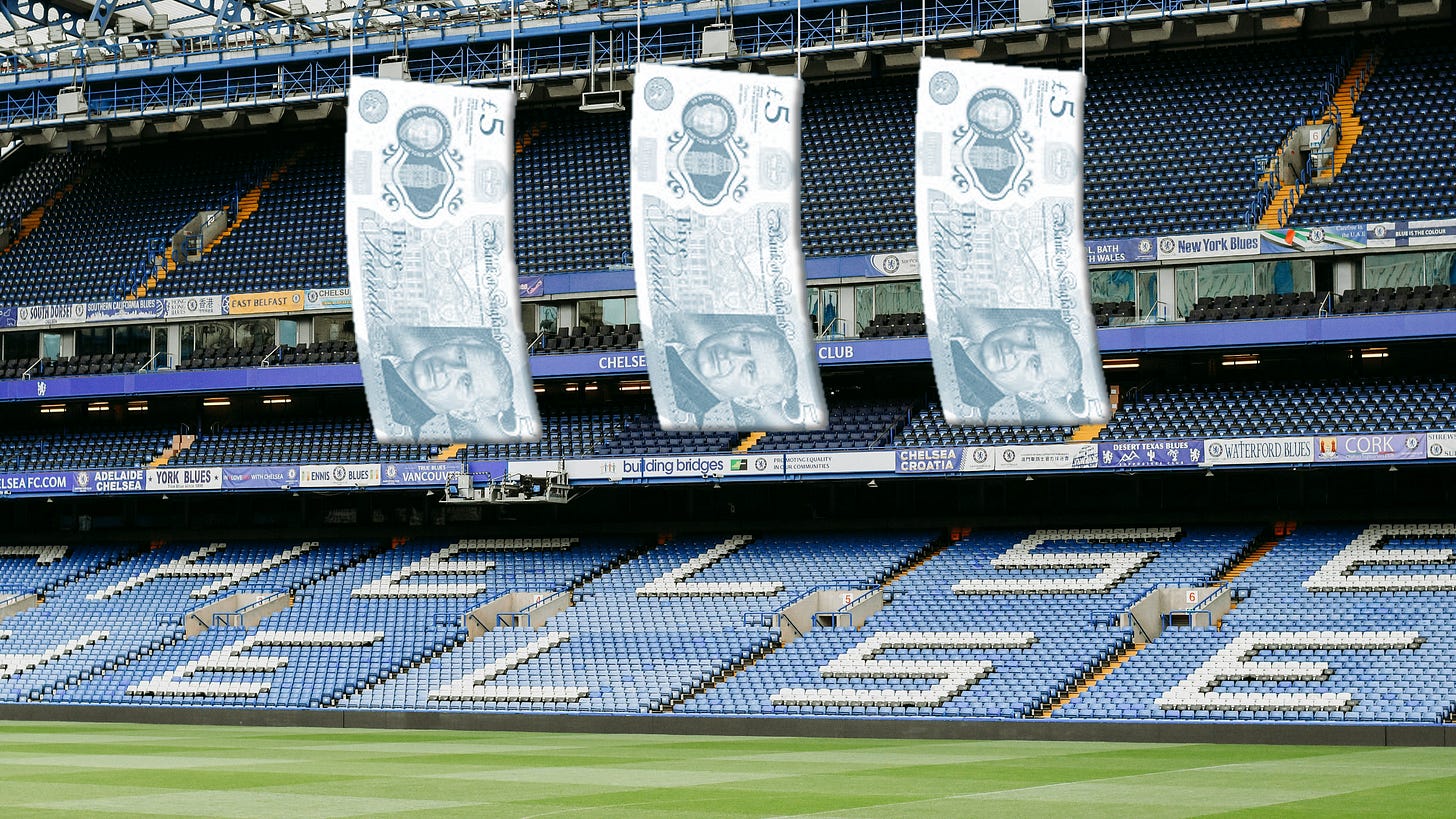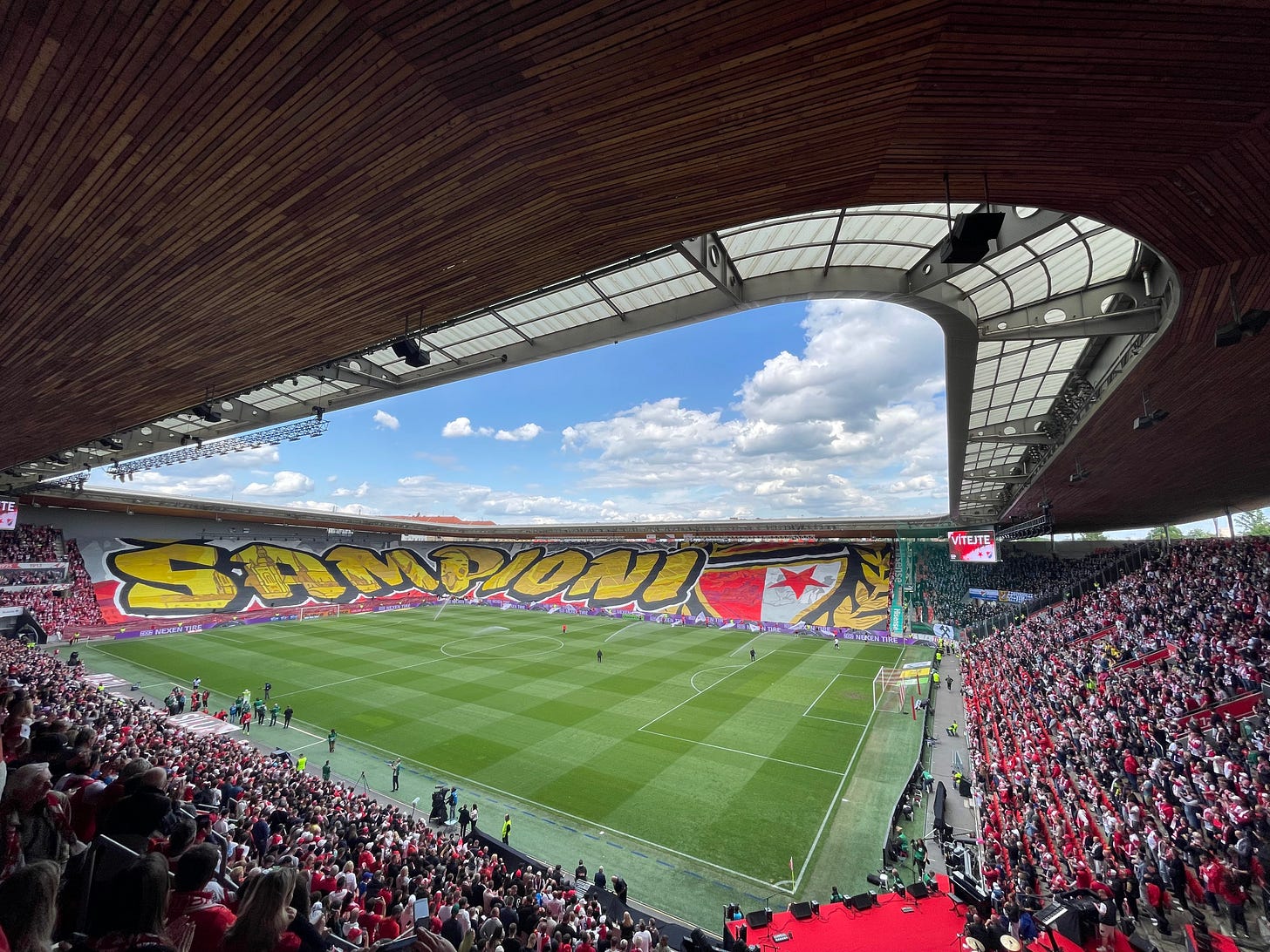What Is the Paper Value of a Football Club? Understanding Club Valuations – Part One
Or rather, is there an ideal method to estimate the financial value of a football club? Beginning with the state-of-the-art Discounted Cash Flow model with SK Slavia Prague FY 2023 example.
In spring 2023, during the sprint writing of my Master’s Thesis, I first began reading about this topic in financial journals covering recent changes in Premier League clubs’ structures. It was also the time of the first major media coverage of FFP violations by CFG, for example. Finance in football had gone mainstream. Thank you
and The Price of Football for helping me complete my studies (for now at least)!The economics of football clubs could be a topic for an entirely dedicated Substack page. As football is the world’s number one sport, it deserves reasonable coverage on Škvára as well. There are many intangible assets connected with owning or supporting any football club: the full emotional rollercoaster of excitement, wonder, love, sadness, anger, even apathy. Then there are families, friendships, broader cultural involvement, fashion, architecture, weekly rituals, the travel industry for those European nights, and last but not least, food. Connecting all of this with clubs’ financials would give a fuller picture of a football club’s economic valuation.
But for now, let’s focus only on the money.
To Maximise or To Minimise?
Maximise Profits or minimise Losses? For professional football clubs relying on repeated money injections from their respective owners, the latter is often more prevalent. Still, in either case, clubs tend to maximise overall shareholder value, at least in the long term. They do, however, choose different means to pursue this difficult task.
This article is not about the incentives of football club owners—if you are looking for more comprehensive research on that, see my Master’s Thesis.
If we set up a KPI to maximise, it inevitably needs to be measured. So the ultimate question remains:
How do we measure the monetary value of a football club?
How else would potential buyers know what they are getting for their pennies?
Discounted Cash Flow is (Maybe) Not the Way
Despite being a well-established and well-researched method within corporate finance, DCF does not fully capture the reality of the football industry. Risk-seeking behaviour of club owners, the inherent uncertainty of sport leading to volatile revenues, player-market inflation, and the variability of profit or loss from player trading all work against relying on this approach.
Let’s build up our case study from the 2023 financial statement of Slavia Prague.
EBITDA
The root, the almighty, the influential EBITDA: Earnings Before Interest, Tax, Depreciation, and Amortisation. This figure serves as the foundation for all future calculations within the DCF model, with the next step being Free Cash Flow. The football market – not only the player market – is worth studying in detail. There is room both for free-trade economic liberalism and for more levelling policies, such as wage caps or parachute payments. Since sport is the core of these businesses, the market remains highly unpredictable. There are, however, a few constants: one is Financial Fair Play (FFP) regulations, the other is taxation.
These are the building bricks:
Total Revenue: 1 297 788 000 CZK
Revenue provides the top-line measure of a club’s economic strength and is the starting point for profitability analysis.Wages: 95 482 000 CZK
One of the largest recurring expenses, directly linked to competitiveness on the pitch.Operating Costs including Player Wages: 1 162 784 000 CZK
These reflect the heavy burden of running a club beyond salaries, covering logistics, staff, and day-to-day operations.Amortisation: 196 950 000 CZK
Critical in football finance, as transfer fees are spread across the length of player contracts.Depreciation: 5 559 000 CZK
Represents the wearing out of physical assets, such as stadiums and facilities.Costs without D&A: 1 055 757 000 CZK
Strips out non-cash charges, useful for assessing operating efficiency.
EBITDA ≈ 242 031 000 CZK
Calculated as Revenue minus Costs without D&A. A key profitability indicator, EBITDA shows the cash-generating ability of the club before financing and accounting adjustments.
It must be noted that this figure is based on personal interpretation of the financial statements. By no means was or is it the true SK Slavia Prague EBITDA for 2023.
EBIT = 39 522 000 CZK
Includes D&A and reflects operating profit, crucial for tax calculation.
Net Operating Profit After Tax (NOPAT) = 32 013 000 CZK
Reveals profit left after taxation, indicating genuine operating efficiency. In Czechia, corporate tax stands at 19%.
+ D&A: 202 509 000 CZK
Adding back depreciation and amortisation corrects for non-cash items that reduce accounting profit but not cash flow.– CapEx estimation: 5 559 000 CZK
Capital expenditure maintains long-term assets, ensuring operational sustainability.– Change in Working Capital: –37 362 000 CZK
A reduction in working capital frees up cash, signalling improved liquidity.
Thus, the Free Cash Flow (FCF) is calculated as:
Not including player trading in this FCF calculation shows the operating-only DCF result at 266 325 000 CZK. However, FCF itself is not sufficient for a complete DCF valuation, since clubs are not perpetuum cash machines – a certain discount rate must always be applied to the future outlook.
Weighted Average Cost of Capital - WACC
The exact formula for WACC is:
where:
E = Market value of equity
D = Market value of debt
Re = Cost of equity
Rd = Cost of debt
T = Corporate tax rate
We want, in fact, to find the market valuation of the club. This requires making certain assumptions in order to estimate the discount rate.
Capital structure: Equity-heavy club, with reliance on owners’ funding → 85% equity, 15% debt
Cost of equity: On the higher end due to volatility in revenue and transfer operations → 15%
Cost of debt: Based on Czech business loan interest rates at the time → 5%
Corporate tax rate: 19%
Risk premium: Add a general sports-club premium of 2% to reflect the uncertainty of sporting results
From these assumptions, the estimated WACC comes out at approximately 15%.
Growth Rate g
Further assumptions must be made about the club’s outlook, market trends affecting revenues, player trading, and overall economic performance.
Club Performance - steady position among the top spots in the Czech league, repeated qualification for European competitions, development of women’s football and the academy → +1.5% contribution to g
Market Trends - revenue growth from increased TV rights and sponsorships, with Czechia still at the lower end of the TV rights market → +1.5% contribution to g
Player Market Inflation - based on CIES calculations1, between 2013 and 2023 transfer-market inflation averaged 9% annually; with player signings representing around 10–20% of revenue → +1.5% contribution to g
Macroeconomic Conditions - GDP growth and inflation rate → +0.5% contribution to g
Future Stadium and Fan Service Improvements → +0.5% contribution to g
Taking all these factors into account, the club is assumed to grow at a sustainable rate of ~5.5%.
Would you add any other factors?
Final Calculation of DCF Model
With all the key elements in place, the road is now open to estimating the enterprise value using FCF, WACC, and the growth rate.
Therefore, our simplified DCF model estimates the Enterprise Value of Slavia Prague to be:
2 957 609 000 CZK
This aligns with the usual story that the EV is above the takeover amount, which for Slavia was estimated at around 2 billion CZK2. On the other hand, current market conditions and internal pressures on both future and previous owners may have contributed to a lower final price.
But stop and consider all the assumptions that had to be made to arrive at this final number. There is always the possibility of focusing on each assumption and inflating the model further. However, attempting to explain assumptions about the future only creates more assumptions about the future.
This is where more direct valuation methods have their place, even though they also incorporate some of the very same assumptions highlighted in this DCF overview.
👉 Follow-Up in Part Two
Next, I will discuss another method for valuing football clubs:
Revenue Multiples – I (maybe) promise fewer formulas and more reading.
Enjoyed this post?
If you’d love to see Škvára bring sports economics insights to more people who shape the game — an ☕️ espresso always helps!







“However, attempting to explain assumptions about the future only creates more assumptions about the future.”
I love that, it made me chuckle!
Super interesting read!!